What would Charles Dickens say if he could see the thousands of teachers sharing lessons for A Christmas Carol with students, celebrating his novella that was published over 175 years ago? If he can look down on us, I bet he’s beaming!
When I began teaching A Christmas Carol, I used the novella. Later, I moved to the play because my students love acting. These lessons will work for both, and I hope you and your students feel the strong sense of community that my students and I did every time we read this amazing story.
Before Beginning A Christmas Carol Lessons
A Christmas Carol takes place in England and Charles Dickens lived in England, so while we’re studying the play or the novella, I like to mix in a couple of non-academic details to build community and make our lessons more memorable experiences.
One is speaking in English accents the ENTIRE time we’re studying the play or novella (about three weeks, from the beginning of class each day until the end). To introduce this idea to my students, I show them this how-to-do-an-English-accent video, which they get a kick out of, especially the part where Alanna, the YouTuber, refers to Hermione. We practice with Alana, and the accents begin. (Most students will participate, but some won’t, and that’s okay.)
I also like to provide props and costumes for the students who are reading. These are the ones we’ve used to represent the characters:
- A bah humbug hat for Scrooge (or Max as pictured below)
- Top hats for Scrooge and/or the other male characters
- A chain for Marley
- An apron for Mrs. Cratchit
- Bonnets for the Cratchit daughters
- A cane for Tiny Time
- A white wig for the Ghost of Christmas Past
- A head wreath for the Ghost of Christmas Present (Currently unavailable, but you can find something similar.)
- A black cloak for the Ghost of Christmas Yet to Come

Funny how such small details can brighten students’ days!
Prereading Activities for A Christmas Carol
Four Videos and a Book
Introduce students to English workhouses with a video such as “The Victorian Workhouse” or “Life in a Victorian Workhouse.” At the beginning of A Christmas Carol, when the two gentlemen ask Scrooge for donations for the poor, Scrooge goes on about how he helps support establishments such as workhouses. Since Dickens is advocating for the poor, and middle schoolers don’t know what workhouses are, this is something I want to discuss with students.
I also like introducing students to authors. For Dickens, I gather students around me as I read the Dickens’ chapter from How They Croaked: The Awful Ends of the Awfully Famous. I also show them one of these videos: “Why Should You Read Charles Dickens?” or “The Life of Charles Dickens.”
Agree or Disagree Theme Activity

Introduce students to some themes from A Christmas Carol without telling them they’re themes.
Before class begins, tape agree and disagree signs on opposite sides of your classroom.
When students arrive, ask them to agree or disagree with statements (such as “Money can’t buy happiness” and “True happiness is found when living for others”) and explain their reasoning.
After they’ve finished, read one statement and ask students to move to the sign that indicates their choice. They then discuss their reasons with a partner or small group.
Extend this activity by allowing a spokesperson from each side debate his/her position. Then move on to the next statement and repeat the process. Close with a discussion on what brings true happiness.
During Reading Lessons for A Christmas Carol
Characteristics of Scrooge on a Poinsettia
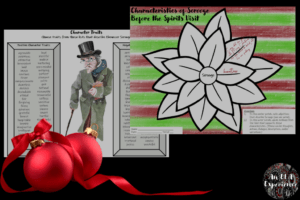
To prepare for this activity, draw or print a flower with a circle in the middle and ten petals (five inner and five outer), and make a copy for each student.
After they have read the opening scene that takes place in Scrooge’s office, give each of them a flower and a list of character traits. They’ll write Scrooge’s name in the center of the flower, five character traits on the inner petals, and five quotes that support those traits on the corresponding outer petals. When they finish, they can color their flowers (with map pencils so you can read what they wrote).
This lesson can be introduced by first completing it with a self-analysis, and both can be published by hanging them on your hallway walls for everyone who passes by to see.
Wheel of Time
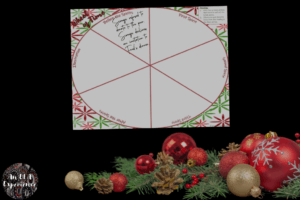
To check for reading comprehension, use paper plates to construct sequence wheels.
Give each student a paper plate, a marker, and a ruler, and have them draw lines across the plates to create six equal sections.
Next, have them label each section as follows:
- Before the Spirits
- First Spirit/Ghost of Christmas Past
- Second Spirit/Ghost of Christmas Present
- Third Spirit/Ghost of Christmas Yet to Come
- After the Spirits
- Illustration
Whenever students finish reading one of the first five sections, direct them to list actions that took place in that section. For example, in the first section, they could write, “Scrooge refuses to donate money to the poor” and “Scrooge declines an invitation for Christmas dinner with his only living relative.” (Work as a whole class on the first section for demonstration purposes. Students can then work independently or with a partner for the remaining sections.)
When they’re finished reading A Christmas Carol, have them draw a picture, symbol, or word to represent their favorite scene in the illustration section. (These can be hung on your walls too.)
A Christmas Carol Bookmark
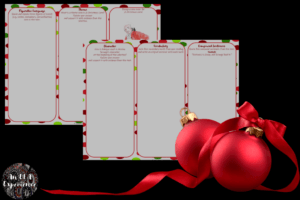
To cover several objectives, try using a bookmark.
Give each student an 8 ½ x 11” sheet of paper and ask them to fold it so they have three sections (like you would a business letter).
Next, have them label each section with titles such as the following:
- Figurative Language
- Theme
- Cover
- Character
- Vocabulary
- Compound Sentences
Throughout your reading of the play or novella, students can note and explain examples of figurative language, explain a theme from a specific scene or stave, design a new cover, explain how dialogue develops Scrooge’s character, write sentences with new vocabulary words, and quote compound sentences.
Freytag’s Pyramid
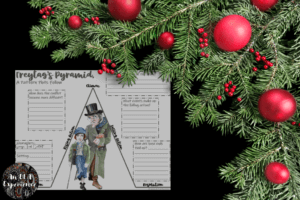
As they read, students can also study plot development with Freytag’s Pyramid by drawing and labeling a pyramid and noting the details that make up the exposition, rising action, climax, falling action, and resolution.
Short-Answer Questions
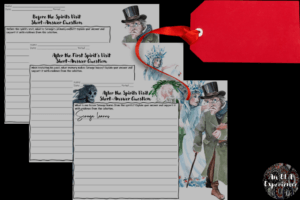
During and after their reading of A Christmas Carol, assess students with short-answer questions:
- Before the spirits visit, what is Scrooge’s primary conflict? Explain your answer and support it with evidence from the text.
- When revisiting his past, what memory makes Scrooge happy? Explain your answer and support it with evidence from the selection.
- What is one lesson Scrooge learns from the spirits? Explain your answer and support it with evidence from the text.
Snowball Theme Fight
Before answering a short-answer question on theme, consider this activity. Students write a theme from A Christmas Carol on a sheet of paper. They then wad the paper, throw it, pick up someone else’s wadded paper, and note evidence that supports that theme.
After Reading Lessons for A Christmas Carol
Post-Mortem of a Protagonist
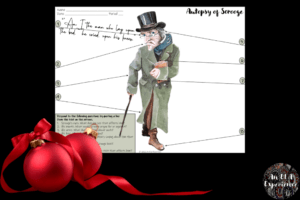
One of my favorite lessons is Post-Mortem of a Protagonist from Laying the Foundation: A Resource and Planning Guide for Pre-AP English.
Students work in small groups (around four students per group). Each group gets a marker, copies of the play or novella, and a light-colored sheet of butcher paper that’s about six feet long.
One student lies on the butcher paper while the other group members outline his/her body with a marker.
They then find lines in the text that support the questions for the various body parts and write them next to that body part as noted in Laying the Foundation: “Eyes–Seeing through the character’s eyes–What memorable sights affect him? How?”
When they are finished with their quotes, they can add details to their outlines to make them resemble Scrooge.
For your classes who work better when they are seated, have them do the same activity but with a sheet of paper with a full-length picture of Scrooge in the center.
Close the activity with class presentations, and publish these by displaying them in the hallway.
Victorian Invitations
Students can create invitations to a party hosted by their favorite Christmas Carol characters.
They begin by folding a sheet of paper in half hamburger style twice.
They then write the invitations by including the following information:
- the host’s name (a character from A Christmas Carol)
- an 1800’s date and location
- food that will be served (noted in the novella at the Cratchit dinner)
- games to be played (noted in the novella at Fred’s Christmas party)
- expected attire (from Victorian period)
Celebrate

Celebrate with a class party. Allow your students to bring snacks to class if they can explain the food’s connection to the novel:
- Candy canes (Tiny Tim’s cane)
- Snowball-shaped cookies (setting)
- Pudding (dessert at Cratchit’s house)
While they snack, play games such as Yes and No (seen at Fred’s party) or watch A Christmas Carol video clips from one of the movies:
- A Christmas Carol with George C. Scott (my favorite because it’s most like the novella)
- Disney’s A Christmas Carol with Jim Carrey
- Mickey’s Christmas Carol
- The Muppet Christmas Carol
Related Links for A Christmas Carol
Lessons for A Christmas Carol (my TPT store)
Five A Christmas Carol Lessons for the Classroom
A Christmas Carol Activity Pack
A Christmas Carol Teacher Resource Guide
Lessons for A Christmas Carol in a Nutshell
- Begin by speaking in an English accent with your students.
- Before reading, introduce students to Dickens, workhouses, and/or themes in A Christmas Carol.
- During reading, use the poinsettia to study character traits, the wheel of time for sequencing, the bookmark for any objectives you want to cover, Freytag’s Pyramid for plot development, and/or short-answer questions for assessment.
- After reading, revisit character with Post-Mortem of a Protagonist or study the time period with a Victorian invitation.
- End with a party with food connected to the novel, games from the time period, and/or a little video entertainment.
I hope Dickens is watching you as you teach these lessons from A Christmas Carol!


